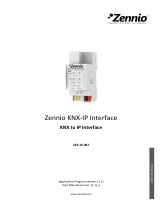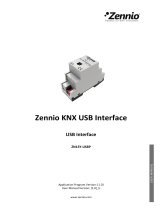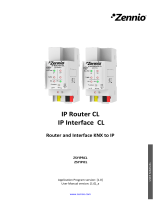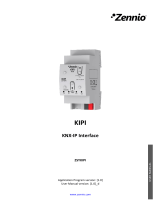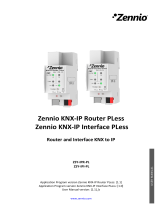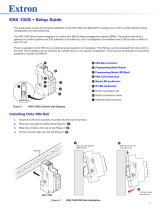Page is loading ...

Zennio KNX-IP Router
KNX-IP Line / Area Coupler
ZSY-IP-ROU
USER MANUAL
Application Program version: [1.0]
User Manual version: [1.0]_a
www.zennio.com

Zennio KNX-IP Router
http://www.zennio.com Technical Support: http://zennioenglish.zendesk.com
2
CONTENTS
Contents ................................................................................................................................ 2
1 Introduction .................................................................................................................. 3
1.1 Zennio KNX-IP Router ............................................................................................ 3
1.2 Installation ............................................................................................................. 5
1.3 Zennio KNX IP Router as a Programmer ................................................................ 6
1.3.1 Parallel Downloads ............................................................................................ 6
1.3.2 Limitations ......................................................................................................... 7
2 Description .................................................................................................................... 8
2.1 Line or Area Coupler .............................................................................................. 8
2.2 Telegram Filtering ................................................................................................. 9
2.3 LED Indicators ...................................................................................................... 11
2.4 Manual Function Button ..................................................................................... 14
2.4.1 Hard Reset to Factory Defaults ....................................................................... 14
2.5 Web Interface ...................................................................................................... 15
2.5.1 Firmware Update ............................................................................................ 16
3 ETS Parameterisation .................................................................................................. 18
3.1 Default Parameterisation .................................................................................... 19
3.2 General ................................................................................................................ 20
3.3 IP Configuration ................................................................................................... 20
3.4 KNX Multicast Address ........................................................................................ 21
3.5 Manual Settings ................................................................................................... 22
3.6 Main Line ............................................................................................................. 23
3.7 Line ...................................................................................................................... 25

Zennio KNX-IP Router
http://www.zennio.com Technical Support: http://zennioenglish.zendesk.com
3
1 INTRODUCTION
1.1 ZENNIO KNX-IP ROUTER
Figure 1 Zennio KNX-IP Router
Zennio KNX-IP Router is the KNX twisted pair to Ethernet line-coupling solution
from Zennio.
IP routers are similar to twisted-pair line couplers, except that they use
Ethernet as the main line.
Zennio KNX-IP Router can be used as a line or area coupler and provides a data
connection between the upper KNXnet/IP line (area line or backbone) and the lower
KNX twisted-pair bus line. It also provides a connection point for ETS to enable
programming (up to four parallel connections) and monitoring the line.
Figure 2. Context (Topology)
Device
Device
LC
LR
Main line
Line
Device
Device
LC
AC
Backbone line
Line

Zennio KNX-IP Router
http://www.zennio.com Technical Support: http://zennioenglish.zendesk.com
4
In contrast to the Zennio KNX-IP Interface device (which offers a simple KNX to IP
coupling solution), Zennio KNX-IP Router incorporates an additional, configurable
telegram filtering system according to their destination group / physical address.
These are the most outstanding features of the device:
Support for long messages (up to 250 bytes).
Use as an area or line coupler with a LAN as main line or main area line,
offering a fast communication medium for telegram exchange.
Up to 4 parallel connections from ETS for programming and monitoring.
Low power consumption.
Traffic filtering according to the project topology and to the built-in address
table.
Telegram dropping.
Blockage of device-configuration telegrams (telegrams destined to
physical addresses).
High capacity buffer for the reception of telegrams from the Ethernet
network.
Web interface to display the device settings, to switch to the programming
mode and for firmware updates.
Customisable pushbutton for triggering the manual mode, useful at runtime
and for set-up and troubleshooting purposes.
7 lighting indicators (LEDs): two bus state indicators per line (with detection
of abnormal situations: excessive bus load, message retransmissions, etc.),
one more indicator per line for the state of the filtering function, and one
additional indicator for the programming mode.

Zennio KNX-IP Router
http://www.zennio.com Technical Support: http://zennioenglish.zendesk.com
5
1.2 INSTALLATION
Figure 3 Element Diagram
This device requires an external power supply (12V to 30V DC) through connector (6),
as it is not powered through the KNX bus.
Figure 3 shows a scheme with all the LED indicators and connections. To couple a
KNX twisted-pair (TP) line and a LAN, the KNX bus (12) and Ethernet (7) cables as
well as the external power (6) must be connected. After the connection, the device can
be conveniently mounted on the DIN rail by the usual procedure
The programming button (11) shown in Figure 3 may be pressed to set Zennio KNX-IP
Router in programming mode. After a short press, the programming LED (5) will light
in red.
The behaviour of the additional LEDs and the manual function button will be described
in section 2.4.
For detailed information about the technical features of the device, as well as on
security and installation procedures, please refer to the device Datasheet, bundled
within the original packaging of the device and also available at http://www.zennio.com
.
1. Main line (LAN) status LED.
2. Main line (LAN) traffic LED.
3. Group address filter status LED.
4. Manual function button.
5. Programming LED.
6. External power supply (12/24V).
7. Main line (LAN) connector.
8. Secondary line (KNX) status LED.
9. Secondary line (KNX) traffic LED.
10. Physical address filter status.
11. Programming button.
12. Secondary line (KNX) connector.
6
12
11
5
10
9
8
4
3
2
1
7

Zennio KNX-IP Router
http://www.zennio.com Technical Support: http://zennioenglish.zendesk.com
6
1.3 ZENNIO KNX IP ROUTER AS A PROGRAMMER
Zennio KNX-IP Router can be used in ETS as a programming interface. In addition to
an IP address, this device must be assigned a KNX individual address for this purpose.
Note: to detect the device as a programmer in ETS, it needs to be powered up and
connected to the same network as the PC, as well as to a TP line. If the latter line is
disconnected, the device will no longer be visible as a programmer.
1.3.1 PARALLEL DOWNLOADS
ETS offers the option to perform multiple parallel downloads from a single project. This
option is only available for connections via a KNX-IP router or a KNX-IP interface.
Certain conditions must be met:
Each download must be performed on a different line.
For each line, it is necessary to select one Zennio KNX-IP Router or one
Zennio KNX-IP Interface to perform the download.
This is configured by right-clicking on the line and, under "Set Connection",
selecting the desired connection (once selected, it will not be available for
other lines).
Figure 4 ETS parallel downloads.

Zennio KNX-IP Router
http://www.zennio.com Technical Support: http://zennioenglish.zendesk.com
7
An additional restriction applies to the parallel downloads: they are not available to
download physical addresses. When performing this type of downloads, the link
device used by ETS is not the one configured for the line but the general one.
1.3.2 LIMITATIONS
It is important to note that Zennio KNX-IP Router, when performing as a programmer,
does not allow bus monitoring (the ETS bus monitor will not be available).
Moreover, Zennio KNX-IP Router does not allow being unloaded (unprogrammed)
from ETS. Equivalently, it can be reset to the factory default state, as explained in
section 2.4.1.

Zennio KNX-IP Router
http://www.zennio.com Technical Support: http://zennioenglish.zendesk.com
8
2 DESCRIPTION
2.1 LINE OR AREA COUPLER
Zennio KNX-IP Router can be used as a line coupler (for coupling both a line to a
mainline) or as an area coupler (for coupling a main line to an area line, also referred
to as backbone line). The operation on both cases is analogous – being a line coupler
or an area coupler only depends on the location of the device within the topology.
Figure 5 shows a typical scenario where Zennio KNX-IP Router can be installed as any
of the nodes the nodes labelled as “AC” (area coupler) or “LC” (line coupler):
Coupling an area line and a main line requires an area coupler (AC). Zennio
KNX-IP Router is intended for cases where the medium of the former is
Ethernet while the medium of the latter is TP.
Coupling a main line and a line requires a line coupler (LC). Zennio KNX-IP
Router is intended for cases where the medium of the former is Ethernet
while the medium of the latter is TP. In such cases, the medium of the area
line (if any) is assumed to be Ethernet as well.
Figure 5 Line Coupling
Whatever the topology, Zennio KNX-IP Router offers an insulated coupling interface
with the possibility of filtering the traffic according to the topology in the installation or
AC
LC
LC
Main Line
Area
Line (backbone)
Line
Line
4.0.0
4.1.0
4.2.0
4.1.2
4.2.2
4.1.1
4.2.1
4.0.1
AC
LC
LC
Main Line
Line
Line
3.0.0
3.1.0
3.2.0
3.1.2
3.2.2
3.1.1
3.2.1
3.0.1

Zennio KNX-IP Router
http://www.zennio.com Technical Support: http://zennioenglish.zendesk.com
9
to group-oriented criteria. In other words, Zennio KNX-IP Router will (or will not) let
telegrams pass from one medium to the other according to the parameterisation.
Note: the individual address of a line coupler needs to be of the form X.Y.0 (or X.0.0 in
case of working as a backbone coupler).
2.2 TELEGRAM FILTERING
The device provides two complementary (and optional) filter types:
Group address filtering: ETS automatically generates a group address table
for the project loaded. This table is transferred to the line coupler during
complete ETS downloads over it.
When a telegram containing a group address in the “destination address” field
arrives, the line coupler will look up if such address exists in the group table,
and eventually transmit the telegram to the other side –if the address is
found– or drop (block) it –if it is not–.
Note: making further changes to a project (addresses, etc.) requires
downloading the updated filter table to the line coupler.
Example: if the line coupler has been parameterised to filter group addresses
from both lines, when it receives a telegram from the mainline destined to a
group address (e.g., 2/5/13) it will check that there is a device in the
secondary line with objects that have been assigned such group address (or
that such address has at least been marked in ETS to pass through the line
coupler; see Figure 6). If so, then the line coupler will let it pass. Otherwise, it
won’t be transferred to the secondary line. The same would also apply to the
inverse case (a telegram originating in the secondary line).
Note: main group addresses in the range 14 to 31 cannot be filtered – only
routing or dropping all telegrams destined to them is possible. The "Preview
of the filter table" option in ETS does show these addresses, but they are not
downloaded to the device in the actual table.

Zennio KNX-IP Router
http://www.zennio.com Technical Support: http://zennioenglish.zendesk.com
10
Figure 6 ETS Option to Force Passing a Group Address through the Line Coupler
Physical address filtering: when the device receives a telegram where the
destination address is a physical/individual address (for example, during
downloads), it will compare such address with its own physical address (no
particular filter table is required for physical address filtering, but a simple
comparison).
The physical address of the line coupler determines the line it belongs to,
which then, and according to the parameterisation, determines if the telegram
will be routed or eventually dropped (blocked). This can be parameterised
separately for the mainline and for the line.
Example: in the example shown in Figure 5, if the coupler with address 3.2.0
reads a telegram on the mainline destined to a device with individual address
3.1.2, it will compare both addresses and conclude that 3.1.2 does not belong
to the secondary line, and therefore not transmit it.
Notes:
The device that sends a telegram needs to have been assigned a physical
address that really corresponds to its line. In Figure 5, if the device with
address 3.1.1 (a KNX programmer, for instance) changes its address to
7.7.255, it will not be able to send telegrams to, for example, the device
with address 4.0.1.

Zennio KNX-IP Router
http://www.zennio.com Technical Support: http://zennioenglish.zendesk.com
11
Important: as device programming consists in sending telegrams destined
to a physical address, in order to make downloads to a device in a certain
line (for example, the device with address 4.1.1 in
Figure 5) from a
programmer not in that line, it is necessary that the line coupler is
configured to let pass all physical addresses from the main line.
2.3 LED INDICATORS
Zennio KNX-IP Router incorporates seven LED lights on the top of the device that
make it easy to monitor the status of the buses and to detect typical communication
problems, as detailed next.
Figure 7 LEDs
Mainline (LAN) Status LED: shows the status of the primary bus.
OFF: error or mainline not connected or not powered.
ON (green) = Ethernet connection OK.
ON (orange) = manual function in execution or factory reset preparation.
Note: the LED colours are independent. It must be taken into account that
when the green and red colours are on at the same time, the result colour
is orange.
The update of the LED status can be delayed a few seconds after the
trigger event, e.g., after the disconnection of the main line.
KNX Line Status LED: shows the status of the secondary bus.

Zennio KNX-IP Router
http://www.zennio.com Technical Support: http://zennioenglish.zendesk.com
12
OFF: error or secondary line not connected.
ON (green): OK
BLINKING (green): boot mode (see section 2.5.1).
ON (red): factory reset in execution (see section 2.4.1).
Note: the LED colours are independent. It must be taken into account that
when the green and red colours are on at the same time, the result colour
is orange.
Mainline (LAN) Traffic LED: shows the traffic status in the Ethernet.
BLINKING (green): traffic.
OFF: no traffic.
ON (red): errors in the transmissions.
KNX Line Traffic LED: shows the traffic status in the secondary bus.
BLINKING (green) = traffic.
OFF = no traffic.
BLINKING (red) = errors in the transmissions.
Group Address (GA) Filter Status LED: shows the current configuration of
the group address routing:
OFF: different configuration for the Ethernet and the secondary lines.
ON (green): filtering active.
ON (red and green = orange): all group addresses routed (filtering
disabled).
ON (red): all group addresses blocked.
Physical Address (PA) Filter Status LED: shows the current configuration
of the individual address routing:

Zennio KNX-IP Router
http://www.zennio.com Technical Support: http://zennioenglish.zendesk.com
13
OFF: different configuration for the Ethernet and the secondary lines.
ON (green): filtering active.
ON (red and orange = yellow): all physical addresses routed (filtering
disabled).
ON (dark orange): all physical addresses blocked.
Note: please be careful not to confuse yellow and dark orange.
Physical Address (PA) programing LED:
OFF = normal operation.
ON (red) = programing mode active.
BLINKING (red) = Ethernet cable disconnected.
Please refer to section 3 for a detailed explanation of the different behaviours and
parameterisations of the Zennio KNX-IP Router application program.

Zennio KNX-IP Router
http://www.zennio.com Technical Support: http://zennioenglish.zendesk.com
14
2.4 MANUAL FUNCTION BUTTON
Zennio KNX-IP Router features an additional pushbutton on the top cover, next to the
status LEDs (see (4) in Figure 3). A three-second press on this button will set the
device in manual mode, thus activating a customisable manual function, and will turn
the main bus status LED orange or red (depending on the previous status of the LED:
green or off). Depending on the parameterised manual function, other LEDs may also
change their colours.
If the manual function button is pressed again for three seconds (or if the
parameterised fall-back timer expires), the device will leave the manual mode and
recover the normal mode. Note that switching from the normal mode to the manual
mode and then back to the normal mode does not cause the loss of the parameters or
filter tables previously downloaded.
In the application program of the device, the selectable manual functions are:
Disabled,
Pass all telegrams,
Pass physical telegrams,
Pass group telegrams.
Please refer to section 3.5 for the parameterisation in ETS of the manual function and
for a detailed description of the different options.
2.4.1 HARD RESET TO FACTORY DEFAULTS
The manual function button permits performing a hard reset of the device, which will
set it back to the factory default state, including the initial individual address. The
default parameters of the device are:
Physical address: 15.15.0.
Host name: KNX-IP router (see section 3.2).
DHCP activated.

Zennio KNX-IP Router
http://www.zennio.com Technical Support: http://zennioenglish.zendesk.com
15
KNX Multicast address: 224.0.23.12 (see section 3.4).
“Transmit all” for group telegrams and physical telegrams.
These are the steps to restore the factory settings:
Press the manual function button for at least 15 seconds. The main line, KNX
line, and group filter state LEDs will light in orange (or red if they were not
green previously) and the physical address filter state LED will turn yellow (or
orange if it was not green previously).
Release the manual function button and press it again for about 5 seconds.
The device will be then automatically reset.
Notes:
Keep in mind that, before entering the reset mode (~15s press), the device
will first enter the manual function mode, which will also make some LEDs
change.
2.5 WEB INTERFACE
Zennio KNX-IP Router provides a web interface for consulting the device
configuration, activating the programming mode or updating the firmware.
The web interface can be accessed through port 8080 of the IP address of the device.
For example, if the IP address is 192.168.1.222:
http://192.168.1.222:8080
The following URL will be equivalent:
http://KNX-IPrt-xxxxxx:8080, where “xxxxxx” refers to the last six digits of the
MAC address of the device.
The IP address of the device can be easily obtained in ETS as long as the device
belongs to the same LAN segment than the PC. On the other hand, the MAC address
must be printed on the cover of the device.
Figure 8 shows the information displayed in the web interface.

Zennio KNX-IP Router
http://www.zennio.com Technical Support: http://zennioenglish.zendesk.com
16
Figure 8 Web interface (device information).
2.5.1 FIRMWARE UPDATE
The “Update” section of the web interface permits updating the internal firmware of the
device whenever Zennio releases a new firmware version (through the
http://www.zennio.com website) by following these steps (please see Figure 9
):
Authorise the update:
Set the device into the programming mode.
Press the manual function button.
Wait for the “update authorized” message on the screen.
Request the update:
From the “Update” section, press the “Request Update” button, and wait
until the device reboots and enters Boot mode.
Upload the firmware:
Browse for the hexadecimal file.
Press the “Upload” button.

Zennio KNX-IP Router
http://www.zennio.com Technical Support: http://zennioenglish.zendesk.com
17
Figure 9 Web interface (firmware update).
After the second step (update request), the device switches to Boot mode, which
interrupts the normal device operation (telegram filtering, etc.), being no longer
possible to connect to it. It will remain in this mode for ten minutes to allow the
firmware update before returning to the normal mode.
During the Boot mode’ the TP line status LED indicator blinks in green.
Notes:
The Boot mode can be alternatively accessed by disconnecting the power
supply and re-connecting it while pressing the Programming or the Manual
Function buttons, or both together.

Zennio KNX-IP Router
http://www.zennio.com Technical Support: http://zennioenglish.zendesk.com
18
3 ETS PARAMETERISATION
To begin with the parameterisation process of the device, it is necessary, once the ETS
program has been opened, to import the database of the product (KNX-IP Router
application program).
Figure10 Properties of the Zennio KNX-IP Router Application Program
Next, the device should be added to the project where desired. Note that, depending
on where the device is placed, the upper levels of the topology need to be configured
as KNXnet / IP:
The backbone line, in case of working as an area coupler.
The backbone line and the main line of the area the device belongs to, in
case of working as a line coupler.

Zennio KNX-IP Router
http://www.zennio.com Technical Support: http://zennioenglish.zendesk.com
19
Figure 11 Zennio KNX-IP Router as an Area Coupler.
Figure 12 Zennio KNX-IP Router as a Line Coupler.
Finally, clicking on the device with the secondary mouse button will permit selecting
"Edit Parameters", in order to start the configuration.
The following sections provide a detailed explanation about each of the different
parameters of the device.
3.1 DEFAULT PARAMETERISATION
When entering the parameter edition of Zennio KNX-IP Router for the first time, a
window similar to Figure 13 will be shown, where six main tabs are available: General,
IP Configuration, KNX multicast address, Manual Settings, Main line and Line.
Note that this application program does not implement communication objects.

Zennio KNX-IP Router
http://www.zennio.com Technical Support: http://zennioenglish.zendesk.com
20
Figure 13 General.
3.2 GENERAL
As shown in Figure 13, this screen contains two parameters:
Host Name: string of up to 30 characters to easily identify the device in ETS
or from a KNXnet/IP system.
Enable Slow Connections: allows slow connections between ETS and the
device.
3.3 IP CONFIGURATION
Figure 14 IP Configuration tab – DHCP: do not use.
/
